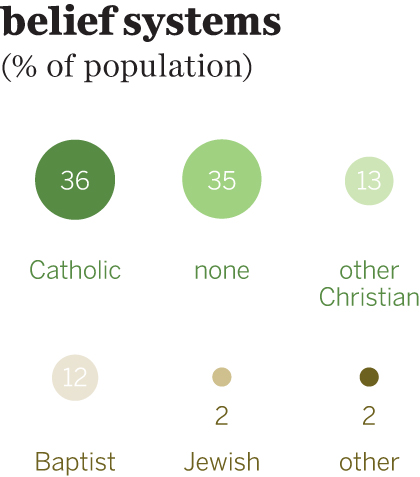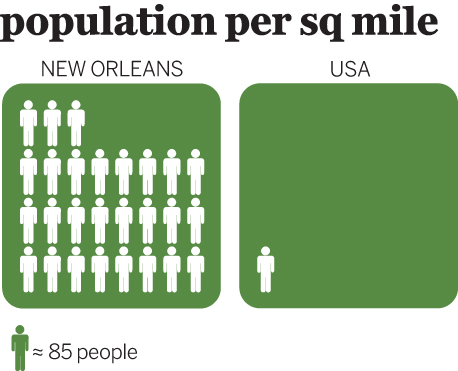New Orleans Today
In 2018, New Orleans celebrated its 300th birthday, but the celebration was not as exuberant as one might expect in the city that gave the world Mardi Gras. This is a city that prides itself on its unchanging character, yet the defining characteristics of 21st-century New Orleans make the city, in some ways, unimaginable to its early settlers. This includes a commitment to the finer things like cuisine and music – the question is, can the majority of the city’s residents enjoy those amenities.
Best on Film & TV
A Streetcar Named Desire (1951) Classic NOLA drama, with Marlon Brando and Vivien Leigh.
The Princess & the Frog (2009) Disney fable that captures the magic and wonder of the city and bayou.
Treme (2010–13) Life, love and music in post-Katrina New Orleans.
12 Years a Slave (2013) The most accurate cinematic portrayal of slavery in the American South.
True Detective, Season 1 (2014) A genre-bending police procedural that dabbles in supernatural horror.
Best in Print
Bienville’s Dilemma (Richard Campanella; 2008) Definitive guide to the city’s physical and cultural geography.
A Confederacy of Dunces (John Kennedy Toole; 1980) Quintessential New Orleans picaresque novel.
Nine Lives (Dan Baum; 2009) Nine oral histories form a cross-section of modern New Orleans.
The World That Made New Orleans (Ned Sublette; 2008) A deep and enjoyable dive into the city’s history.
The Awakening (Kate Chopin; 1899) One of the first American novels written from a woman’s perspective.
A.D. (Josh Neufeld; 2009) Graphic novel of the days leading to, and following, Hurricane Katrina.
A Changing Demographic
For most of the 20th century, New Orleans was, demographically speaking, considered a city of black and white – that is to say, African American and Caucasian. This dynamic has been changing for the past two decades, and has been exacerbated by Hurricane Katrina. While the metropolitan area lost some of its black population due to the storm, the population vacuum was not necessarily filled by white transplants. A significant amount of Asian and Hispanic ‘new’ New Orleanians arrived, adding to existing Honduran, Vietnamese, and Chinese American communities. Some wags have called this demographic trend the ‘browning’ of New Orleans.
We say ‘metropolitan area’ because many new arrivals are settling in the suburbs just outside of New Orleans. Williams Boulevard in Kenner – packed with South American, Central American and Asian restaurants – might be more cosmopolitan than any street in Orleans parish proper. The suburb of Metairie is now packed with international grocery stores selling tortillas and rice wine. A Latin American flea market sets up in Algiers every weekend, and Honduran and Mexican food trucks can be found outside any parking lot where migrant laborers converge. Within New Orleans, spots like Casa Borrega and stretches of New Orleans East are the center of local Hispanic and Asian gravity.
Louisiana Land Loss
All of the issues facing New Orleans are overshadowed by the fact that there may not be a New Orleans in a century. Louisiana is experiencing some of the fastest rate of land loss in the world. Since 2010, some 58 square miles of the state have been swept underwater.
The culprit? Coastal erosion, saltwater intrusion, decreased sediment deposits due to dams, canals and levees, oil and gas excavation that cause the land to lose structural integrity, and rising sea levels caused by climate change. At the end of the day, this state’s economy is deeply tied to resource extraction, and resource extraction is linked to land loss. Some argue the fiscal wealth the energy sector creates can be invested in battling land loss, but increasingly, locals are wondering if those benefits fill state coffers.
Many legislators swear by Louisiana’s Industrial Tax Exemption Program (ITEP), which ostensibly creates incentives, via tax breaks and other benefits, for businesses to stay in the state. There is mounting evidence that the ITEP’s exemptions are so broad, the state is losing billions of dollars in lost taxes while businesses hire a bare minimum of local labor. The series ‘No Strings Attached,’ published by the Baton Rouge Advocate, is a comprehensive investigation into the fiscal fallout of the ITEP.
New Orleans skews to the political left, and land loss has become a major priority for her citizens. The situation has been primed for a showdown between the city and the state, and in a larger sense, Louisiana and the Gulf of Mexico.
The Night They Drove Old Dixie Down
One of the most heated battles of the current culture wars was fought in New Orleans in 2017. Following the Charleston church massacre by a white supremacist known for sporting Confederate flag regalia, then-mayor of New Orleans Mitch Landrieu called for the removal of four controversial New Orleans monuments. His decision was spurred by vigorous activism from groups like Take ’em Down NOLA.
Three were statues of Confederate slave holders – Robert E Lee, Jefferson Davis and PGT Beauregard. One was a monument to the ‘battle’ of Liberty Place, an 1874 paramilitary insurrection led by the Crescent City White League against the racially integrated Reconstruction-era Louisiana state government. The White League murdered black police officers, and the monument’s inscription once read, in part, ‘the national election of November 1876 recognized white supremacy in the South and gave us our state.’
That line spoke to the symbolism of the other statues, which were all erected long after the Civil War technically ceased in 1865. Landrieu argued – and historians agreed – that these statues were specifically raised in opposition to Reconstruction and integration. Later, they became rallying points for those opposed to Civil Rights.
The Liberty Place statue was removed on April 24, 2017 – Confederate Memorial Day in Mississippi and Alabama – amid threats of violence; one contractor who offered to remove the Lee statue found his car torched in a parking lot. The other three statues were removed in May of 2017 without incident, besides some angry protests. The statues will be moved to as-of-yet undetermined facilities, where they can be studied as artifacts of history, rather than venerated in a place of civic honor.


